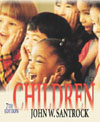John W. Santrock,
University of Texas, Dallas
| adolescence | the developmental period of transition from childhood to early adulthood, entered at approximately 10 to 12 years of age and ending at 18 to 22 years of age.
(See 20)
|
 |
 |
 |
| biological processes | changes in an individual's physical nature.
(See 19)
|
 |
 |
 |
| cognitive processes | changes in an individual's thought, intelligence, and language.
(See 19)
|
 |
 |
 |
| context | the settings, influenced by historical, economic, social, and cultural factors, in which development occurs.
(See 15)
|
 |
 |
 |
| continuity-discontinuity issue | focuses on the extent to which development involves gradual, cumulative change (continuity) or distinct stages (discontinuity).
(See 21)
|
 |
 |
 |
| cross-cultural studies | comparisons of one culture with one or more other cultures. These provide information about the degree to which children's development is similar, or universal, across cultures and about the degree to which it is culture-specific.
(See 15, 559)
|
 |
 |
 |
| culture | the behavior patterns, beliefs, and all other products of a group that are passed on from generation to generation.
(See 15)
|
 |
 |
 |
| development | the pattern of change that begins at conception and continues through the life span.
|
 |
 |
 |
| early childhood | the developmental period that extends from the end of infancy to about 5 to 6 years, sometimes called the preschool years.
(See 20)
|
 |
 |
 |
| early-later experience issue | the issue of the degree to which early experiences (especially infancy) or later experiences are the key determinants of the child's development.
(See 22)
|
 |
 |
 |
| ethnicity | a characteristic based on cultural heritage, nationality characteristics, race, religion, and language.
(See 15)
|
 |
 |
 |
| gender | the social and psychological dimension of being male or female.
(See 16, 318)
|
 |
 |
 |
| infancy | the developmental period that extends from birth to 18 to 24 months.
(See 20)
|
 |
 |
 |
| innate goodness view | the idea, presented by Swiss-born philosopher Jean-Jacques Rousseau, that children are inherently good.
(See 7)
|
 |
 |
 |
| middle and late childhood | the developmental period that extends from about 6 to 11 years of age, approximately corresponding to and sometimes called the elementary school years.
(See 20)
|
 |
 |
 |
| nature-nuture issue | involves the debate about whether development is primarily influenced by nature or nurture. Nature refers to an organism's biological inheritance, nurture to environmental experiences.
(See 21)
|
 |
 |
 |
| original sin view | advocated during the Middle Ages, the belief that children were born into the world as evil beings and were basically bad.
(See 7)
|
 |
 |
 |
| prenatal period | the time from conception to birth.
(See 20)
|
 |
 |
 |
| social policy | a national government's course of action designed to influence the welfare of its citizens.
(See 16)
|
 |
 |
 |
| socioemotional processes | changes in an individual's relationships with other people, emotions, and personality.
(See 19)
|
 |
 |
 |
| tabula rasa view | tabula rasa view the idea, proposed by John Locke, that children are like a "blank tablet."
(See 7)
|



 2003 McGraw-Hill Higher Education
2003 McGraw-Hill Higher Education

 2003 McGraw-Hill Higher Education
2003 McGraw-Hill Higher Education